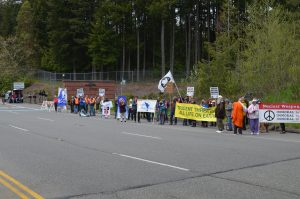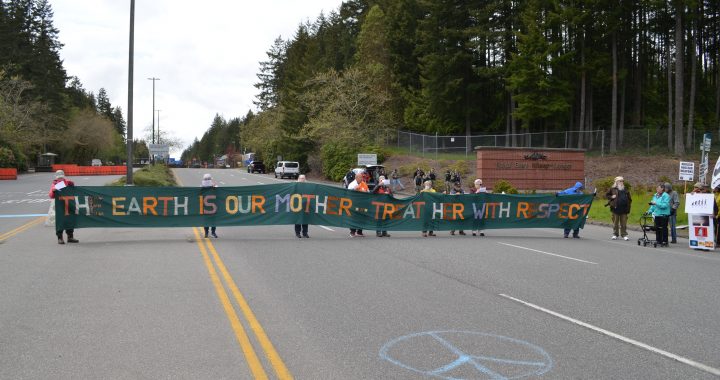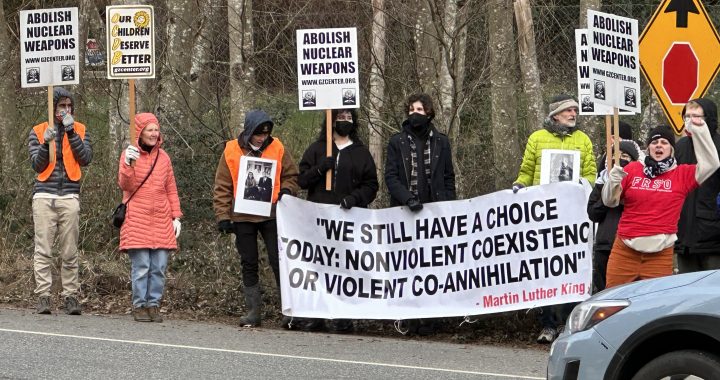Over 50 people were present on May 7, at the demonstration against Trident nuclear weapons at the Bangor submarine base. Nine demonstrators blocked the main highway entrance into the base for about 10 minutes and were cited by the Washington State Patrol.
At around 2:15 pm on Saturday, the nine demonstrators entered the highway carrying a large banner stating, “THE EARTH IS OUR MOTHER—TREAT HER WITH RESPECT” and blocked all incoming traffic at the Main Gate at Naval Base Kitsap-Bangor. They were removed from the highway by the Washington State Patrol.
All nine demonstrators were cited for violating RCW 46.61.250, Pedestrians on roadways, and released at the scene.
Those cited by the Washington State Patrol: Brenda McMillan and Caroline Wildflower of Port Townsend; Margarita Munoz of Seattle; Sue Ablao of Bremerton; Carolee Flaten of Hansville; Rev. Gilberto Perez of Bainbridge Island; Ramon Nacanaynay of Shoreline; Michael “Firefly” Siptroth of Belfair; and Tom Rogers of Poulsbo, WA. 
Mother’s Day in the United States was first suggested in 1872 by Julia Ward Howe as a day dedicated to peace. Howe saw the effects on both sides of the Civil War and realized destruction from warfare goes beyond the killing of soldiers in battle.
Earlier, on Saturday morning, a tribute was held for Robert C. Aldridge, peacemaker and guiding inspiration for Ground Zero and Trident resistance who passed away on April 29. Statements for Robert Aldridge were read from Shelley Douglass and Jim Douglass. Shelley Douglass stated, “This campaign began with a Trident designer, and a conscientious family making a decision to resist, together. That’s why, from the very beginning, this campaign has seen Trident workers as potential partners in the work. It’s why we leafleted for so long, why we try to build relationships and community across fences and lines. It’s why so many people who once disagreed have become part of the community…” An 8-minute video of Robert Aldridge in 1980 is at https://youtu.be/klSzBKDOJ68.
Kathryn Railsback then spoke on war and nonviolence and her work with trauma survivors from around the world. With Friends Peace Teams, Kathryn Railsback has traveled multiple times to East Africa and co-facilitated workshops in several countries, with a focus on the Democratic Republic of Congo and the Kakuma Refugee Camp in Kenya. Her work with war survivors has strengthened her beliefs in pacifism and the need to promote nonviolence as a way of life. Kathryn Railsback stated, “The production and possession of nuclear weapons is an outgrowth of the mistaken view that we can find peace through creating fear of violence.”
Members of the Seattle Peace Chorus Action Ensemble performed throughout the day. A new and original song by Doug Balcom was performed for the first time: “If we can close each nuclear base, That imperils the human race, We’ll all be the lucky ones.” The Action Ensemble also performed at the Main Gate to the submarine base.
About 50 sunflower seedlings were planted during the day, in rows along the fence separating Naval Base Kitsap-Bangor and Ground Zero. Sunflowers are the symbol of a world free of nuclear weapons. On June 1, 1996, Ukraine transferred to Russia for dismantlement the last of the 1,900 nuclear warheads it had inherited from the former Soviet Union. Celebrating the occasion a few days later, the Defense Ministers of Ukraine, Russia, and the United States met at a former nuclear missile base in the Ukraine that once housed 80 SS-19 missiles aimed at the United States. They planted sunflowers and scattered sunflower seeds.
 Ukrainian President Leonid Kuchma said, “With the completion of our task, Ukraine has demonstrated its support of a nuclear weapons free world.” He called on other nations to follow in Ukraine’s path and “to do everything to wipe nuclear weapons from the face of the Earth as soon as possible.” U.S. Secretary of Defense William Perry said, “Sunflowers instead of missiles in the soil would ensure peace for future generations.”
Ukrainian President Leonid Kuchma said, “With the completion of our task, Ukraine has demonstrated its support of a nuclear weapons free world.” He called on other nations to follow in Ukraine’s path and “to do everything to wipe nuclear weapons from the face of the Earth as soon as possible.” U.S. Secretary of Defense William Perry said, “Sunflowers instead of missiles in the soil would ensure peace for future generations.”
Naval Base Kitsap-Bangor is homeport to the largest concentration of deployed nuclear warheads in the U.S. The nuclear warheads are deployed on Trident D-5 missiles on SSBN submarines and are stored in an underground nuclear weapons storage facility on the base.
There are eight Trident SSBN submarines deployed at Bangor. Six Trident SSBN submarines are deployed on the East Coast at Kings Bay, Georgia.
One Trident submarine carries the destructive force of over 1,200 Hiroshima bombs (the Hiroshima bomb was 15 kilotons).
Each Trident submarine was originally equipped for 24 Trident missiles. In 2015-2017 four missile tubes were deactivated on each submarine as a result of the New START Treaty. Currently, each Trident submarine deploys with 20 D-5 missiles and about 90 nuclear warheads (an average of 4-5 warheads per missile). The warheads are either the W76-1 90-kiloton or W88 455-kiloton warheads.
The Navy in early 2020 started deploying the new W76-2 low-yield warhead (approximately eight kilotons) on select ballistic submarine missiles at Bangor (following initial deployment in the Atlantic in December 2019). The warhead was deployed to deter Russian first use of tactical nuclear weapons, dangerously creating a lower threshold for the use of U.S. strategic nuclear weapons.
The next planned demonstration will be the annual Ground Zero Peace Fleet demonstration on August 1, 2022 in Elliott Bay.
The next planned demonstration at Bangor and events at Ground Zero will be on August 7, 8 and 9, 2022.
The Ground Zero Center for Nonviolent Action was founded in 1977. The center is on 3.8 acres adjoining the Trident submarine base at Bangor, Washington. We resist all nuclear weapons, especially the Trident ballistic missile system.
Note: Photos by Glen Milner




